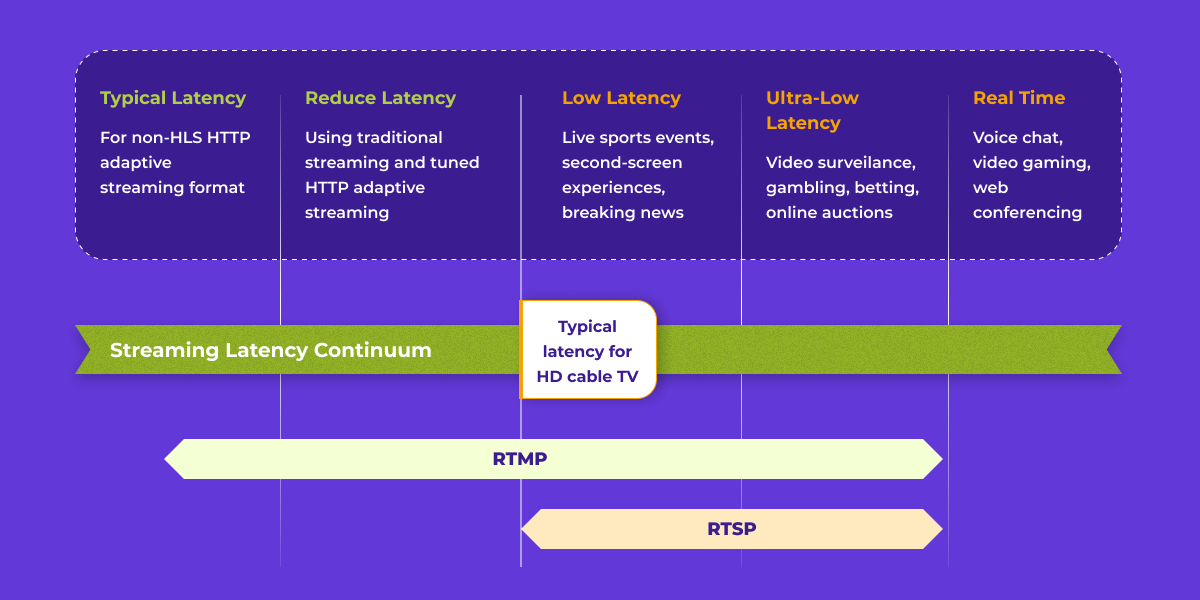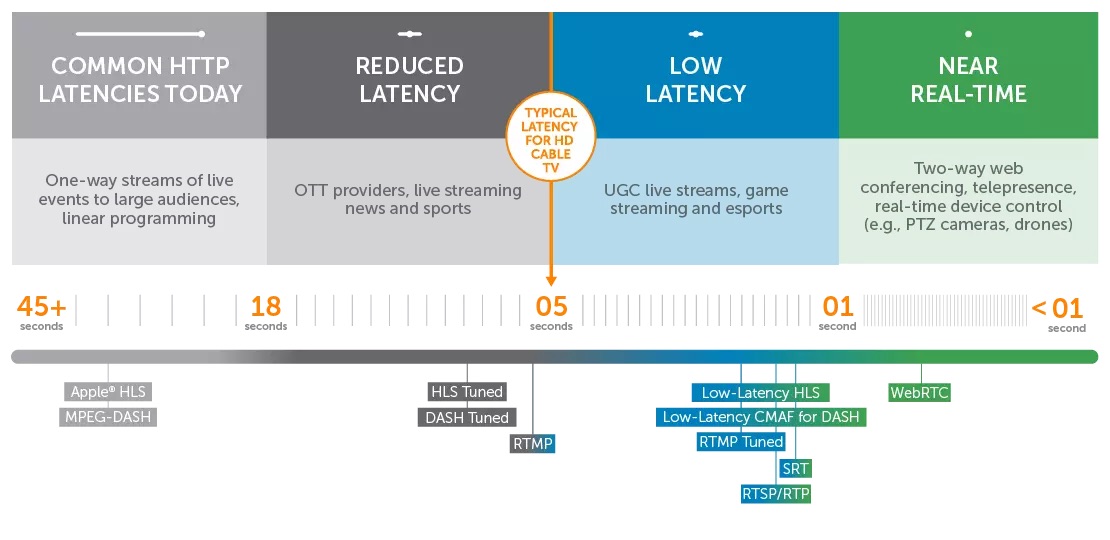RTMP, RTSP, and HLS are protocols for streaming video content online. RTMP is ideal for low-latency streaming, RTSP suits real-time communications, and HLS is best for adaptive bitrate streaming.
RTMP (Real-Time Messaging Protocol) is widely used for live streaming due to its low latency. RTSP (Real-Time Streaming Protocol) is often employed in surveillance and video conferencing applications. HLS (HTTP Live Streaming) is favored for its adaptability, supporting various devices and network conditions.
Each protocol has its strengths and weaknesses, making them suitable for different use cases. Understanding these differences can help you choose the right streaming technology for your specific needs, ensuring a seamless viewing experience for your audience.
RTMP Protocol
O RTMP protocol is a vital part of streaming technology. It was created by Adobe Systems. It stands for Real-Time Messaging Protocol. RTMP ensures low-latency transmission of audio, video, and data.
What Is RTMP?
RTMP is a protocol used for streaming audio, video, and data. It is ideal for live streaming. RTMP maintains persistent connections. It enables low-latency communication. It was designed to work with Flash Player.
Principais características
- Low latency streaming
- Support for video and audio
- Persistent connection
- Ideal for live broadcasts
Prós e contras
| Prós | Contras |
|---|---|
| Low latency | Not supported on iOS devices |
| High quality | Requires Flash Player |
| Supports live interactions | Not suitable for on-demand content |

Rtsp Protocol
O Real-Time Streaming Protocol (RTSP) is a network control protocol. It is used for establishing and controlling media sessions between endpoints. RTSP is widely used in entertainment and communication systems.
What Is RTSP?
RTSP stands for Real-Time Streaming Protocol. It is designed to control streaming media servers. RTSP acts as a “network remote control” for media servers. Clients use RTSP to issue commands like play, pause, e stop.
RTSP is not responsible for actual data transmission. It works in conjunction with protocols like RTP (Real-Time Transport Protocol) to deliver media streams.
Principais características
- Client-Server Architecture: RTSP follows a client-server model. The client sends requests; the server responds.
- Two-Way Communication: RTSP supports bidirectional communication. It allows clients to control playback in real-time.
- Session Management: RTSP manages sessions. Each session can control multiple streams.
- Compatible with RTP: RTSP works well with RTP. This ensures efficient media delivery.
Prós e contras
| Prós | Contras |
|---|---|
| Real-time control over media streams | Complex to implement |
| Supports multiple data formats | Limited scalability |
| Low latency | Requires a stable network |
| Session management capabilities | Not suitable for large-scale broadcasting |
HLS Protocol
O HLS Protocol is a streaming method used widely today. It stands for HTTP Live Streaming. Developed by Apple, it delivers media content over the internet.
What Is Hls?
HLS, or HTTP Live Streaming, is a protocol for streaming media. It was created by Apple. This protocol breaks the stream into small chunks. These chunks are downloaded and played by the player.
Principais características
- Adaptive Bitrate Streaming: Adjusts quality based on network speed.
- Compatibilidade: Works on most devices and platforms.
- Escalabilidade: Handles large audiences without issues.
- Security: Supports encryption and secure streaming.
Prós e contras
| Prós | Contras |
|---|---|
|
|
Performance Comparison
When streaming video, performance is key. RTMP, RTSP, and HLS are popular protocols. Each has strengths and weaknesses. Let’s dive into their performance.
Latência
Latência is the delay between capturing and displaying video. Lower latency is crucial for live events.
| Protocol | Latência |
|---|---|
| RTMP | 2-5 seconds |
| RTSP | 1-2 seconds |
| HLS | 10-30 seconds |
RTSP offers the best latency. HLS has the highest delay.
Escalabilidade
Escalabilidade refers to handling many viewers. This is vital for popular streams.
- RTMP scales well with dedicated servers.
- RTSP struggles with large audiences.
- HLS uses CDN, making it very scalable.
HLS outshines others in scalability.
Compatibilidade
Compatibilidade ensures the stream works on various devices.
- RTMP primarily supports Flash. Limited support on mobile.
- RTSP needs special players. Poor browser support.
- HLS works on most modern devices and browsers.
HLS has the best compatibility across platforms.
Use Cases
Understanding the use cases of different streaming protocols can help you choose the right one for your needs. This section explores the best protocols for live streaming, on-demand streaming, and low latency.
Best For Live Streaming
RTMP is often chosen for live streaming. It offers a stable connection and low latency. RTMP is compatible with many streaming platforms and services. It is also easy to set up. If you need reliable live streaming, RTMP is a strong choice.
HLS can also be used for live streaming. It works well with most devices. HLS streams are delivered in small chunks, which can add some latency. But it is very scalable and secure. HLS is a good option if you need wider device support.
Best For On-demand Streaming
HLS is excellent for on-demand streaming. It breaks down the video into small segments. This allows for adaptive bitrate streaming. Users get the best quality based on their network. HLS is widely supported on many devices and browsers.
RTSP can also be used for on-demand streaming. It is less common but very efficient. RTSP streams directly from the server to the client. This ensures smooth playback. It is ideal for applications needing quick access to video files.
Best For Low Latency
RTMP is the go-to for low latency streaming. It maintains a steady connection with minimal delay. This makes it ideal for real-time interactions. If low latency is crucial, RTMP is your best bet.
RTSP also offers low latency. It is often used in surveillance systems. RTSP provides real-time streaming with minimal delay. This makes it suitable for câmeras de segurança and live monitoring.
Technical Considerations
Understanding the technical aspects of streaming protocols can help in making the right choice. Let’s dive into the technical considerations of RTMP, RTSP, e HLS.
Network Requirements
Each protocol has different network requirements that can impact performance.
- RTMP: Requires a stable and high-speed internet connection.
- RTSP: Works well on local networks with low latency.
- HLS: Optimized for delivery over HTTP, suitable for varying network conditions.
RTMP is ideal for low-latency streaming but needs more bandwidth. RTSP is suitable for controlled environments. HLS handles network fluctuations better due to its adaptive bitrate.
Device Support
Device compatibility is crucial for a seamless streaming experience.
| Protocol | Device Compatibility |
|---|---|
| RTMP | Limited support on mobile devices and modern browsers. |
| RTSP | Primarily supported on IP cameras and surveillance systems. |
| HLS | Wide compatibility across mobile devices, browsers, and smart TVs. |
HLS is the most versatile protocol, supported by many devices. RTMP e RTSP have more specialized uses and limited compatibility.
Security
Security is a key consideration for any streaming protocol.
- RTMP: Supports basic security with RTMPS (RTMP over SSL).
- RTSP: Has limited built-in security features.
- HLS: Offers robust security with HTTPS and token-based authentication.
HLS provides the best security features, making it suitable for sensitive content. RTMP offers some level of security, while RTSP is less secure.
Future Of Streaming Protocols
The future of streaming protocols is evolving rapidly. New technologies are shaping how we view live content. Rtmp, Rtsp, and Hls are key players in this space. Let’s explore what lies ahead for these protocols.
Emerging Technologies
Emerging technologies are driving change in the streaming world. Artificial Intelligence (AI) e Machine Learning (ML) are enhancing viewer experiences.
- AI and ML improve qualidade do vídeo.
- 5G networks promise faster and more reliable streams.
- Edge Computing reduces latency and buffering.
Industry Trends
Industry trends are shaping the future of streaming. Businesses are adopting new practices to keep up.
- Interactive content is becoming popular.
- Personalized streaming is on the rise.
- Cross-platform compatibility ensures streams work everywhere.
| Technology | Impacto |
|---|---|
| AI and ML | Enhances video quality and user experience. |
| 5G Networks | Faster, more reliable streaming. |
| Edge Computing | Reduces latency and buffering. |
Businesses must adapt to these trends. This ensures they remain competitive in the streaming market.

Perguntas frequentes
What Is The Difference Between Rtmp And Rtsp?
RTMP is mainly used for live streaming to platforms. RTSP is designed for real-time media over networks. RTMP supports lower latency. RTSP is more flexible.
Which Protocol Is Better For Live Streaming?
RTMP is better for live streaming due to its lower latency. It’s widely used by platforms like YouTube and Facebook.
Can Hls Be Used For Live Streaming?
Yes, HLS can be used for live streaming. It is HTTP-based and widely supported. It provides good compatibility with various devices.
Is Rtsp Still Relevant Today?
RTSP is still relevant, especially for IP cameras and surveillance systems. It’s less common for public streaming but useful for certain applications.
Conclusão
Choosing between RTMP, RTSP, and HLS depends on your streaming needs. RTMP offers low latency. RTSP is great for live streaming. HLS provides compatibility with multiple devices. Each protocol has its strengths and use cases. Assess your specific requirements to make the best choice for your streaming solution.



